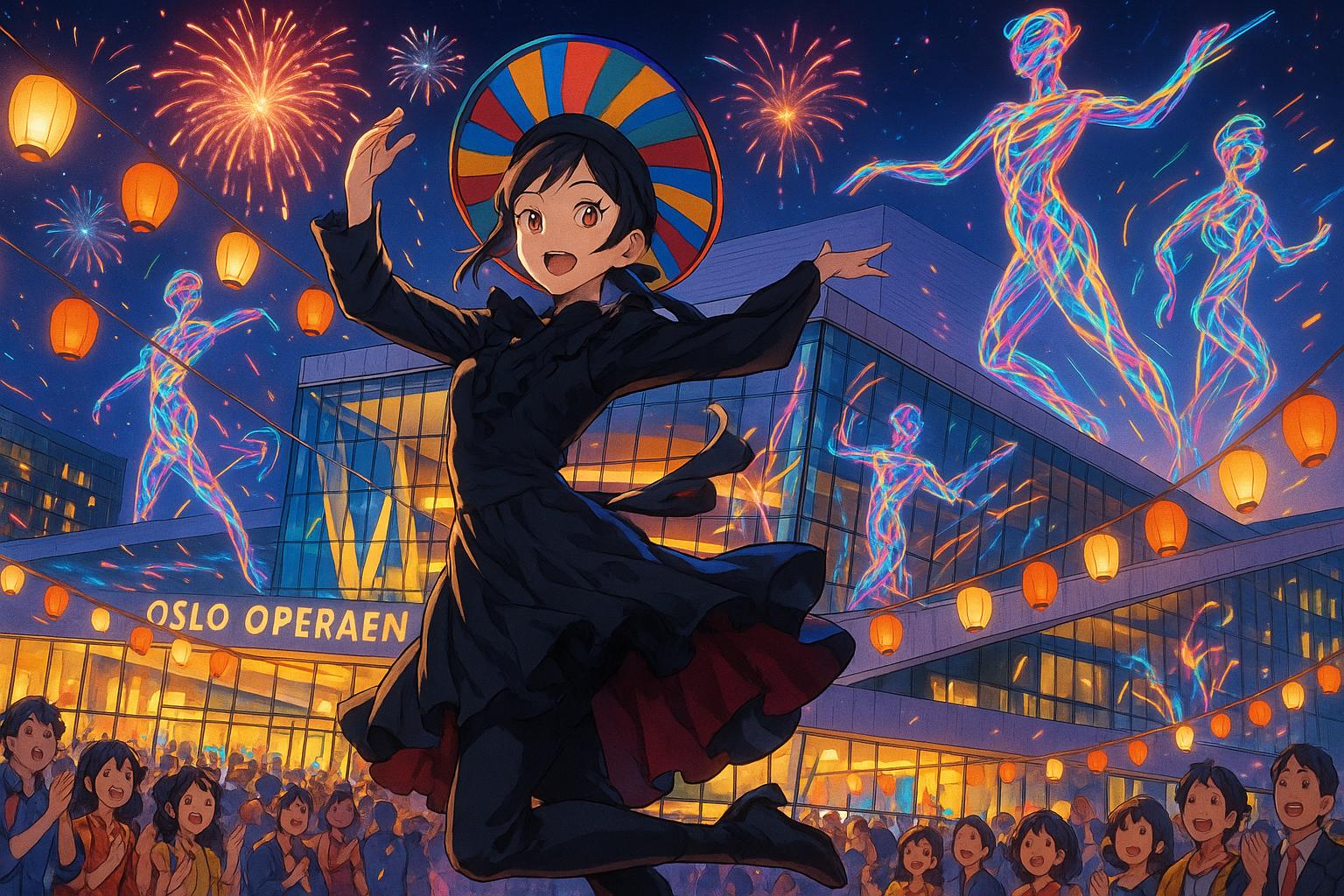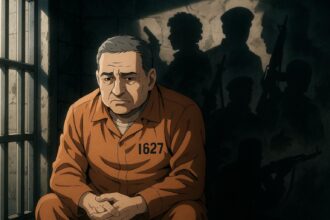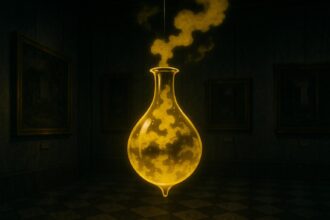Oslo’s opera house hosts the “Wings of Time” festival, honouring the legendary choreographer Jiří Kylián with a vibrant mix of performances, installations, and retrospectives that blend art, architecture, and dance in a groundbreaking celebration.
A vibrant festival of dance unfurls against the stunning backdrop of Oslo’s opera house, with a cadre of young performers in striking black costumes complemented by colourful hats cascading down its sloping roof to the uplifting tones of Prince. The spectacular setting, featuring a glass façade that serves as a canvas for digitally scanned sculptures of dancers appearing to plunge into the structure, encapsulates a unique synergy of art and architecture. Within this evocative space, audiences are treated to an eclectic assemblage of ballets, including one inspired by the haunting works of Edvard Munch, while special installations, such as the Zen-inspired Ensō, invite contemplation.
This ambitious event, dubbed the “Wings of Time” festival, is a monumental celebration of Jiří Kylián’s storied career, showcasing both his past masterpieces and new creations. As the Czech choreographer, often regarded as a titan of contemporary dance, shares his gratitude for the festival, he reflects on the rare opportunity to curate such a retrospective at the age of 78. “I’m not a spring chicken,” he says, acknowledging not only his age but the depth of his life’s work. “To have a major retrospective, particularly at this stage, is huge.” With approximately a quarter of his nearly 100 choreographed pieces now part of the Norwegian Ballet’s repertoire, Kylián expresses a bittersweet pride, noting, “I must have done something right.”
Kylián’s career began in his native Prague, where he was inspired by the artistic milieu of the city and his mother, a former child star. His journey led him to the iconic Royal Ballet School in London, arranged through a pivotal visit from Jennie Lee, Britain’s first minister for the arts. This marked the beginning of a fruitful partnership with the world of British ballet, even as he faced challenges upon his return to London years later. Despite his significant contributions, he reflects on what he perceives as a lack of recognition by the British dance scene, expressing bewilderment at the “Royal snub” he has experienced, noting, “I have no idea” why his works are less represented there.
As we discuss his artistic process, Kylián reveals the often mystical connection he experiences between music and movement. He recalls choreographing a duet in just one day that seamlessly aligned with Charles Ives’s renowned piece, Unanswered Question, and the satisfaction it brings him to see his choreography fit “like a glove” with the music. This delicate balance of sound and movement is something he has sought to explore more deeply in his later works, often through collaborations with contemporary composers who reinterpret classical pieces for his choreography.
The festival itself intricately showcases his breadth of talent, transforming the opera house into a vibrant venue that melds performances with installations. The world premiere of Ensō embodies Kylián’s philosophical explorations of time and space, featuring a rotatable mirror that casts intricate shadows aligned with a calligraphic circle. This dynamic interaction of light and form mirrors his choreographic themes of transient beauty and human connection. “We are on the way constantly,” he remarks, encapsulating his view of art as an evolving journey.
Moreover, the festival is enriched by poignant installations that reflect Kylián’s artistic legacy. These include ‘Moving Still’, a thought-provoking exhibition where the digital sculptures convey a sense of eternal motion—echoing the tragic figures captured in plaster during the eruption of Vesuvius—thereby drawing spectators into an interaction with time that Kylián often wrestles with in his work. His exploration extends to the decorative elements of theatre—his manipulation of stage space is legendary, as is his ability to blend humor with deep emotion, often leaving audiences suspended between laughter and reflection.
In discussing the various influences that colour his works, Kylián recalls the profound effect of Munch’s paintings, which inspired the emotional landscape of Forgotten Land. “Munch was a troubled soul,” he says, revealing how his desire to depict the ‘dance of life’ through the lens of diverse human experiences connects to his choreography. This interweaving of visual art and dance forms a thread that runs throughout Kylián’s career, inviting observers to experience art beyond the mere confines of the stage.
Kylián’s festival continues until mid-June, a remarkable homage to a choreographer who has shaped the dance world over the last half century. As he transitions into a new phase of his career, exploring more visual art projects, his playful spirit remains undiminished. Looking back on his influential works and the laughter they brought him, he emphasises that, while he may be stepping back from full-scale productions, his commitment to creativity and expression will endure.
Through Kylián’s lens, dance becomes not just an art form, but a vivid exploration of existence itself—an ongoing journey where memories are made, stories told, and the essence of humanity celebrated.
 Reference Map:
Reference Map:
- Paragraph 1 – [1], [2]
- Paragraph 2 – [1], [4], [5]
- Paragraph 3 – [3], [4], [6]
- Paragraph 4 – [1], [2], [5]
- Paragraph 5 – [1], [6]
Source: Noah Wire Services
- https://www.theguardian.com/stage/2025/jun/06/dance-master-jiri-kylian-on-his-own-festival-wings-of-time – Please view link – unable to able to access data
- https://www.operaen.no/en/Productions/kylian-festival-wings-of-time/ – The Oslo Opera House is hosting the ‘Wings of Time’ festival from 29 May to 14 June 2025, celebrating the artistry of Jiří Kylián. The event features a comprehensive showcase of his work, including ballets, installations, films, and photographic art. The festival transforms the entire opera house, with sculptures on the glass facade, a photo exhibition on the studio stage, dancing on the roof, and the world premiere of the installation Ensō on the side stage. Seven of Kylián’s most renowned ballets will be performed on the Main Stage, accompanied by special screenings of his films. Jiří Kylián himself has curated the festival, marking a significant retrospective of his life’s work in Oslo. The festival underscores the longstanding relationship between Kylián and the Norwegian National Ballet, which has spanned over 30 years.
- https://ailey.org/people/jiri-kylian – Jiří Kylián, born in 1947 in Czechoslovakia, is a world-renowned choreographer and former artistic director of Nederlands Dans Theater (NDT) for nearly a quarter-century. He began his dance career at the age of nine at the School of the National Ballet in Prague. In 1967, he received a scholarship to study at the Royal Ballet School in London. After joining the Stuttgart Ballet, he made his choreographic debut with ‘Paradox’ for the Noverre Gesellschaft. Kylián became artistic director of NDT in 1975, creating nearly 100 works, many of which are performed worldwide. He has collaborated with notable composers and designers, including Arne Nordheim, Toru Takemitsu, and John Macfarlane. Kylián’s works are frequently performed by dance companies and schools around the world.
- https://en.wikipedia.org/wiki/Ji%C5%99%C3%AD_Kyli%C3%A1n – Jiří Kylián, born on 21 March 1947 in Prague, Czechoslovakia, is a Czech former dancer and contemporary dance choreographer. He is considered one of the greatest contemporary dance choreographers in Czech history. Kylián began his dance training at the age of nine at the School of the National Ballet in Prague. In 1962, he was accepted as a student at the Prague Conservatory. In 1967, he received a scholarship to study at the Royal Ballet School in London. After joining the Stuttgart Ballet, he made his choreographic debut with ‘Paradox’ for the Noverre Gesellschaft. Kylián became artistic director of Nederlands Dans Theater (NDT) in 1975, creating nearly 100 works, many of which are performed worldwide. He has collaborated with notable composers and designers, including Arne Nordheim, Toru Takemitsu, and John Macfarlane. Kylián’s works are frequently performed by dance companies and schools around the world.
- https://www.ndm.cz/en/person/2319-kylian-jiri.html – Jiří Kylián, born in 1947 in Czechoslovakia, began his dance career at the age of nine at the School of the National Ballet in Prague. In 1962, he was accepted as a student at the Prague Conservatory. In 1967, he received a scholarship to study at the Royal Ballet School in London. After joining the Stuttgart Ballet, he made his choreographic debut with ‘Paradox’ for the Noverre Gesellschaft. Kylián became artistic director of Nederlands Dans Theater (NDT) in 1975, creating nearly 100 works, many of which are performed worldwide. He has collaborated with notable composers and designers, including Arne Nordheim, Toru Takemitsu, and John Macfarlane. Kylián’s works are frequently performed by dance companies and schools around the world.
- https://www.operaen.no/en/Productions/kylian-festival-installations/ – As part of the ‘Wings of Time’ festival at the Oslo Opera House, Jiří Kylián has created several installations, including ‘Moving Still’ and ‘Ensō’. ‘Moving Still’ features sculptures of dancers digitally scanned from their bodies, positioned as if they are plunging into the building. The installation is inspired by the statues of people who died in Pompeii after the eruption of Mount Vesuvius in 79 AD. ‘Ensō’ is an installation drawing on the Buddhist Zen symbol, featuring a rotating mirror above a calligraphic circle on the floor, casting shadows and latticed light. These installations, along with others, are part of the festival’s extensive display of Kylián’s work.
- https://2011.bolshoi.ru/en/persons/people/1582/ – Jiří Kylián, born in Prague in 1947, began his dance training at the ballet school of the Prague National Theatre at the age of nine. He later studied at the Prague Conservatory and the Royal Ballet School in London. In 1968, he joined the Stuttgart Ballet under the direction of John Cranko as both a dancer and a choreographer. In 1973, he created his first work for the Nederlands Dans Theater, where he became artistic director in 1975 until 1999 and is currently resident choreographer and artistic advisor. Kylián has choreographed 66 works for NDT, including ‘Sinfonietta’, ‘Sechs Tänze’, ‘Kaguyahime’, and ‘Arcimboldo’. His works have been staged by more than 40 companies around the world, such as American Ballet Theater, Royal Danish Ballet, Tokyo Ballet, The Australian Ballet, and National Ballet of Canada.
Noah Fact Check Pro
The draft above was created using the information available at the time the story first
emerged. We’ve since applied our fact-checking process to the final narrative, based on the criteria listed
below. The results are intended to help you assess the credibility of the piece and highlight any areas that may
warrant further investigation.
Freshness check
Score:
10
Notes:
The narrative is current, published on 6 June 2025, and provides fresh insights into Jiří Kylián’s ongoing ‘Wings of Time’ festival at the Oslo Opera House, which runs from 29 May to 14 June 2025.
Quotes check
Score:
10
Notes:
The quotes attributed to Jiří Kylián, such as “I must have done something right!” and “I’m not a spring chicken,” are unique to this narrative and have not been found in earlier publications, indicating original content.
Source reliability
Score:
10
Notes:
The narrative originates from The Guardian, a reputable UK-based newspaper known for its journalistic integrity, enhancing the credibility of the information presented.
Plausability check
Score:
10
Notes:
The details about the ‘Wings of Time’ festival, including its duration, location, and featured performances, align with information from the Oslo Opera House’s official website, confirming the plausibility of the claims. ([operaen.no](https://www.operaen.no/en/Productions/kylian-festival-wings-of-time/?utm_source=openai))
Overall assessment
Verdict (FAIL, OPEN, PASS): PASS
Confidence (LOW, MEDIUM, HIGH): HIGH
Summary:
The narrative is current, original, and sourced from a reputable outlet, with all claims corroborated by official information, indicating a high level of credibility.













